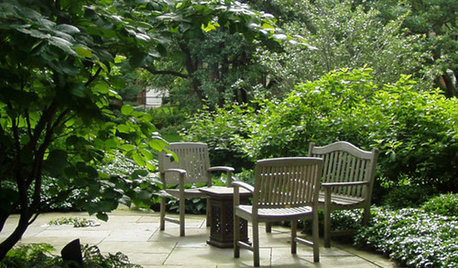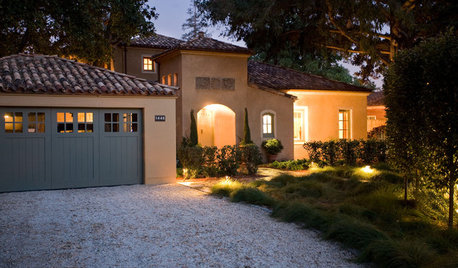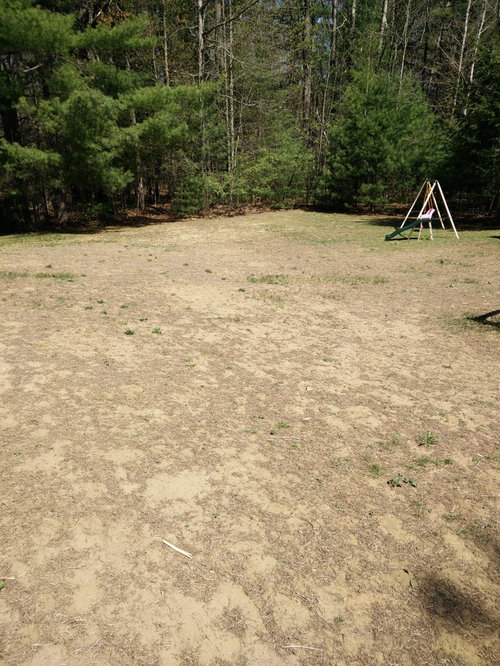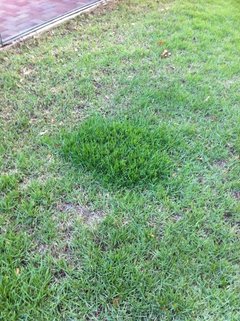Extremely Sandy Lawn. Rough Shape
Jay Smith
9 years ago
Featured Answer
Sort by:Oldest
Comments (35)
User
9 years agoJay Smith
9 years agoRelated Discussions
Garden bed shapes - enbracing the un-natural....
Comments (30)I doubt that I'm ever going to convince many/any of you that straighter lines are good - or any of you conivince me that wavy lines are best! To each his own is the conclusion I think:-) Karin - From the deck, or in the space, the lines of the first of laag's drawings would still be what pleases me most. That gently rounded quasi-rectangular lawn is a shape I like (you might remember I have a rather larger version of that in my backyard!) and I can 'feel' myself moving easily along the path around the tree and to the front yard. I just think that flows better... v1rtu0s1ty - when I mean straight lines when there are planting beds, that what I 'see' - i.e. the edges are naturally softened by plants spilling over during the growing season. But the clear lines are still there guiding you deep into the garden and will still be making a strong statement in the off-seasons when the plants are not visible or less showy. sleepy - sorry, but I prefer the straight path version :-) If I'm going from point A to point B, I prefer to get there along the shortest path (which is a straight line). If there's no reason for a wiggle, it annoys me to have to follow that longer path. With a nice planting, a straight path doesn't have to be unattractive. I've posted this picture here before - straght path along the north side of our house - June 2009:...See More'best' riding lawn mower or lawn tractor up to $1000 ?
Comments (63)Must of been lucky. Bought an MTD at Ace hardware (Ace Special Edition) with a 42" cut and 16hp Tecumseh. Aside from the normal problems of your MTD of that era IE having the grille mounts break off after a few years) it's been great, and it was only replaced as it was really starting to not work well on hills, and in the last year has been a case of "What's going to break next when I mow?". A key to remember is any NEW tractor in that range is going to be light duty. If you have more an acre to mow with it, a newer, higher end, used model is a probably a better option. You'll get a lot of life out of one though if you keep it well maintained. Take care of it and there is no reason why you should not get a good, usable life of about 10-12 years. one other thing to keep in mind; the chief complaints of many people on a mower it seems is the motor. That is the most important part of a mower besides the transmission on a Hydro equipped tractor. The engine is going to what will go wrong 9 time out of 10 on a mower, and is often going to be to blame for issues with cutting (due to lack of power) and reliability....See MoreLeveling lawn with soil...no sand????
Comments (10)So that is what we originally thought. However, we have tried both slice seeding (2 years ago) and overseeding (last year) and you see the results. Last fall we overseeded and tried to lightly put in some leftover garden soil I had in some of the lower patchy areas to try and enrich the soil. The only grass that grew was in the areas where we added the soil (we did use a rake to the other areas to make sure good contact with the seed). However, the little grass that did take had roots lower than the rest of the grass. We made sure to water multiple times a day and had caution tape around it to keep the kids off. Since the only grass that grew was in the better/new soil and since we've been told by other landscapers that our soil is too sandy, I thought topdressing with loam/compost mix would both help to enrich our soil with nutrients along with helping the low spots. Figured we'd probably overseed after top dressing also....See MoreLab results are back, could use some help getting lawn into shape.
Comments (7)This is a nice initial soil test. There's some work to be done, but the starting point on this soil is pretty good. EC 6.2: Sandy soil, with a little silt. Plan on testing this soil yearly as it'll shift fast. OM 2.1%: At the lower border of Fair, starting to trend toward Poor. With your lower EC, I'd always feed organically, always mulch mow, mow in all your fall leaves, steal your neighbors' leaves in fall, and so on. While not an emergency or anything, bringing this up will positively impact your lawn quality, raise your EC a little bit, and vastly improve water retention in your soil. pH 7.0: A little high due to excess magnesium in the soil. Sulfur 13: Normal, with tons of margin to play with if I need it. I'll use a little of the margin, but not very much as your soil won't require that much playing. Phosphorus 101: Low but not extreme, this is still negatively impacting your lawn quality. Target in this case will be around 220. I recommended starter fertilizer below. Just choose the cheapest as they'll all target around 1 pound of phosphorus per thousand square feet. Calcium 65.7%: Exactly optimal. The soil shows a tiny deficit of 48 pounds per acre (about 1 pound per thousand) but we can ignore it this year. That's too small to bother with and difficult to correct without going over the top. Given your pH, we definitely don't want to do that. Magnesium 25.0%: Very high, which will tend to give you a tight, impenetrable soil. Avoid all magnesium sources, including dolomitic limestone and Epsom salt. Let's give this a year to leach out normally, by which time you'll probably need calcium anyway--and we can use one step to add a little Ca while abolishing a touch of Mg at that point if needed. Potassium 2.2%: Although OK by the percentage, the numbers are low. Plus I'm a fan of moving K to the upper part of the recommended percentages or even a little beyond. It improves heat and cold resistance, disease resistance, and insect resistance. Most landscape and garden stores will order potassium sulfate (sulfate of potash) for you, or you can get it online. Recommendations below. Minor Elements: Boron is low and I discuss that next. Except for iron, all others are OK. Iron is below boron. Boron 0.38: Low. Boron is used in photosynthesis and cell differentiation, so it's kind of important. We use 20 Mule Team Borax as the boron source, which is available at your local grocery store in the laundry section, plus Milorganite as a carrier. In a wheelbarrow or the like, dump the Milo. Spraying very, very lightly with water (I use a spray bottle like the kind people use to damp their clothes when they iron) will help the boron stick. Add the recommended amount of 20 Mule Team Borax and stir, spraying occasionally to get the stuff to stick to the Milo. Then apply over the recommended area. So if going for bag rate Milorganite (1 bag per 2,500 square feet), you'd add 10 tablespoons of 20 Mule Team Borax. Iron 77: Low. Not deficient, but not going to give you the best color or best photosynthesis in the lawn. Any time you like, apply Milorganite to slowly raise the iron levels in the soil and organic matter levels in the lawn. The boron listed above only goes once, on July 1. The rest of the Milo applications should be with nothing added. Recommendations: Memorial Day Weekend: Apply starter fertilizer at bag rate. June 15: Apply 2 pounds per thousand square feet of potassium sulfate. July 1: Apply 4 tablespoons of 20 Mule Team Borax in Milorganite. Labor Day: Apply starter fertilizer at bag rate. September 15: Apply 2 pounds per thousand square feet of potassium sulfate. October 1: Apply starter fertilizer at bag rate....See MoreUser
9 years agolast modified: 9 years agoUser
9 years agoJay Smith
9 years agoJay Smith
8 years agoUser
8 years agoUser
8 years agoJay Smith
8 years agoJay Smith
8 years agoUser
8 years agoJay Smith
8 years agoUser
8 years agoJay Smith
8 years agoUser
8 years agoJay Smith
8 years agoUser
8 years agolast modified: 8 years agodchall_san_antonio
8 years agoJay Smith
8 years agolast modified: 8 years agoJay Smith
8 years agoUser
8 years agoUser
8 years agoJay Smith
8 years agoJay Smith
8 years agolast modified: 8 years agoJay Smith
8 years agoUser
8 years agodchall_san_antonio
8 years agoJay Smith
8 years agoUser
8 years agoJay Smith
8 years ago
Related Stories

BEFORE AND AFTERSSee 6 Yards Transformed by Losing Their Lawns
Wondering whether a turf lawn is the best use of your outdoor space? These homeowners did, and they found creative alternatives
Full Story
GROUND COVERSGive Your Lawn a Taste of the Wild
Consider the joys of an irregularly trimmed meadow lawn: It’s ecofriendly, visually interesting and still good for romping
Full Story
EARTH DAYThe Case for Losing the Traditional Lawn
Work less, help the environment and foster connections by just saying no to typical turf
Full Story
LANDSCAPE DESIGNGet Along With Less Lawn — Ideas to Save Water and Effort
Ditch the mower and lower your water bill while creating a feast for the eyes with diverse plantings and gathering places
Full Story
GARDENING AND LANDSCAPINGYour Yard: Are You Ready to Lose the Lawn?
Save time and water with good-looking alternatives to turf grass
Full Story
LANDSCAPE DESIGN15 Great Ideas for a Lawn-Free Yard
End the turf war for good with hardscaping, native grasses and ground covers that save water and are easier to maintain
Full Story
LANDSCAPE DESIGNCalifornia Says Goodbye to the Sprawling Ornamental Lawn
New state rules will effectively limit turfgrass to 25 percent of the landscape in most new and renovated yards
Full Story
FRONT YARD IDEASBefore and After: Front Lawn to Prairie Garden
How they did it: Homeowners create a plan, stick to it and keep the neighbors (and wildlife) in mind
Full Story
REMODELING GUIDESGravel Driveways: Crunching the Pros and Cons
If you want to play rough with your driveway, put away the pavers and choose the rocky road
Full Story
SAVING WATERXeriscape Gardens: How to Get a Beautiful Landscape With Less Water
Conserve water and make gardening much easier with the xeriscape approach’s 7 principles
Full Story
















User